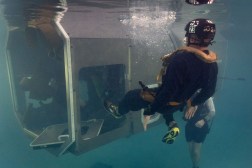SOCOM looking to acquire new drone-launched glide bombs

U.S. Special Operations Command wants to arm lightweight drones with new glide bombs, and it’s gearing up to evaluate vendors’ solutions.
A technology assessment event hosted by the SOFWERX innovation hub, in partnership with Army Special Operations Command and Army Space and Missile Defense Command, is slated for April.
The aim is to “advance efforts in developing and producing an advanced light-weight precision glide munition,” according to a special notice.
“USSOCOM is seeking industry submissions for a precision glide munition that is smaller than the GBU-69 and that can be delivered by light-weight uncrewed aircraft,” officials wrote. “The government is interested in the development and eventual fielding of a low-cost, light-weight, precision, unpowered, air-launched glide munition to fill the gap for glide munitions smaller than the GBU-69” for use by special operations forces.
The GBU-69/B — which can be carried by AC-130 gunships or unmanned aerial systems — is 42 inches in length, has a 4.5-inch diameter and a wingspan of 28 inches, and weighs 60 pounds, according to manufacturer Dynetics, a Leidos company. The system has previously been launched from an Army MQ-1C Gray Eagle Extended Range drone manufactured by General Atomics Aeronautical Systems, per a 2019 GA-ASI press release.
SOCOM wants a similar type of weapon that weighs 30 pounds or less, including the warhead, according to assessment criteria.
“Warhead types are interchangeable by the operator and should include: airburst with adjustable height above ground setting, point detonation, and penetration,” officials wrote.
The munition should be able to hit targets upwards of 100 kilometers away from the host air vehicle that launches it.
“The munition will have a built-in data link to send its location and receive in-flight instructions to change targets or self-destruct,” per the assessment criteria.
The system must be able to navigate in an electromagnetically contested environment and not be dependent on GPS. The command would prefer at least three methods of navigation, officials noted.
SOFWERX is requesting information from industry about “existing mature capabilities” that might fit the bill for the Gliding Offensive Lightweight Unmanned Munition (GOLUM) assessment event in Tampa, Florida, the city where SOFWERX and SOCOM headquarters are both located.
“USSOCOM will downselect those respondents/submissions they feel have the highest potential to satisfy their technology needs. Favorably evaluated submissions will receive an invitation to attend the AE on/around 18 March 2025,” per the notice.
The assessment event is slated for the April 8-10 timeframe. Afterward, the command seeks to enter into Federal Acquisition Regulation-based or non-FAR agreements with vendors whose solutions are favorably evaluated by subject matter experts from Army Special Operations Command and Army Space and Missile Defense Command, according to officials.






